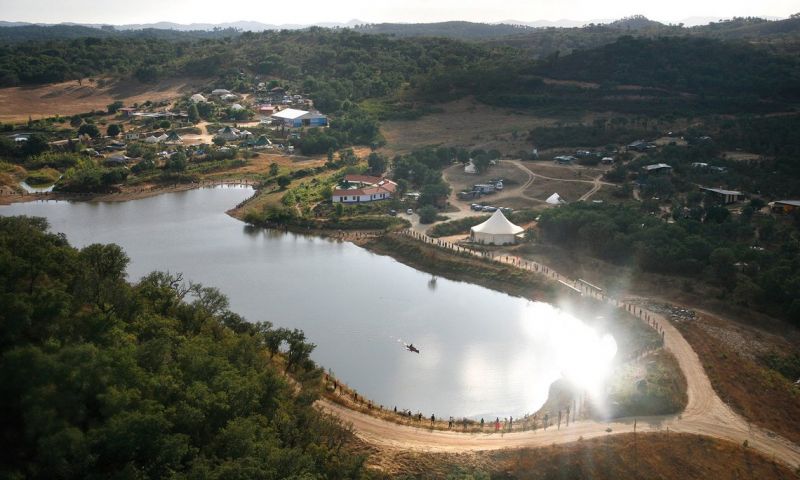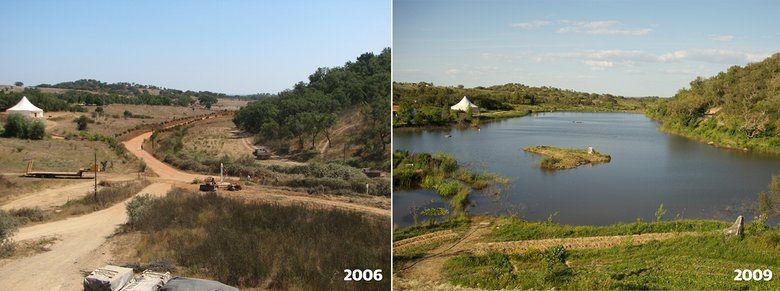Arid Land to a Fertile Eden: Permaculture Lessons from Portugal
Published on by Water Network Research, Official research team of The Water Network in Non Profit
Tamera’s ecology experts transformed an area at risk of desertification – and say they can do the same anywhere in the world.

The Tamera site covers 330 acres in southern Portugal and is home to 200 people. Photograph: Nigel Dickinson
The land is called Tamera, the name given to these 330 acres in southern Portugal by a community of 30 people who moved here from Germany in 1995. Today, 200 people from all over the world live here.
Through simple practices of digging swales (ditches) and creating water retention spaces, Tamera’s ecology experts have transformed an area on the brink of desertification – and say they can do the same anywhere in the world.
The community wanted to be more sustainable and grow more of their own food, rather than importing it, and it was clear that water would be central to being able to live autonomously on the land.
“When I came to Tamera in 2006, trees were dying and wells were drying out,” says Bernd Mueller, director of Tamera’s Global Ecology Institute and one of the engineers behind the transformation.
At that time, in the summer months, Tamera looked like a desert with hardly any vegetation. In the winter months, however, there was heavy rainfall and flooding. Mueller and his co-engineer Thomas Lüdert realised that most of the water was running off the soil and causing damage to infrastructure, rather than soaking into the earth.
It rushed down to the rivers causing erosion and other damaging side effects,” says Mueller. The project’s goal, then, was to retain all the rainwater that falls on the land, to refill the groundwater which was getting lower each year, and to provide flowing spring water.

A composite image showing the Tamera site before reconstruction in 2006, and after in 2009. Photograph: Tamera
They started from the top of the hills, hit hardest by erosion and overgrazing. “The wind and the water eroded all the fine earth that should serve as a sponge for the rainwater,” says Mueller. “We started to manipulate the situation so these places retain the rainwater falling on them. Then you start to build structures like swales, which fill with rainwater and slowly filter into the earth.”
The lakes were dug out and formed without any concrete seal at the bottom so water can seep into the earth. “There’s a principle in permaculture called the triple S – slow, spread and sink,” says Mueller. “When you have flowing rainwater, something in your ecosystem is wrong. You have to slow it down, spread it over the land and let it sink.”
Transformation of the landscape began in August 2007, and by February 2008 a new spring had appeared at the edge of Tamera’s boundary. “I was surprised. I didn’t expect that to happen so fast,” says Mueller. “We suddenly had a creek going through the valley, and that brought more lush vegetation and animals; wildlife responds immediately to constant access to water.”
The Tamera case study has been presented to the EU and at the UN’s Cop22 in Marrakech by the Global Ecovillage Network. “For us it was important from the beginning to change the situation in Tamera, but do it in a way that it will be a model for the rest of the world,” says Mueller, who has travelled most continents to consult on water projects.
“When you scale the ecological problems down to principles, it’s all due to the same mistakes. In all the cases I have seen all over the world, the key to ecosystem restoration is rainwater and vegetation management.”
Mueller has consulted on water management in Israel and Palestine, Turkey, Jordan, Kenya, Togo, Brazil, Bolivia, Colombia, and has shown how the Tamera model can be used in development and humanitarian settings.
Read more at: The Guardian
Media
Taxonomy
- Resource Management
- Water Supply
- Community Supply
- Water Management
- Infrastructure
- Groundwater Resource
- Eco-City Development
- Community